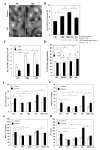Pharmacological promotion of autophagy alleviates steatosis and injury in alcoholic and non-alcoholic fatty liver conditions in mice
- PMID: 23339953
- PMCID: PMC3634371
- DOI: 10.1016/j.jhep.2013.01.011
Pharmacological promotion of autophagy alleviates steatosis and injury in alcoholic and non-alcoholic fatty liver conditions in mice
Abstract
Background & aims: Pharmacological approaches can potentially improve fatty liver condition in alcoholic and non-alcoholic fatty liver diseases. The salutary effects of reducing lipid synthesis or promoting lipid oxidation have been well reported, but the benefits of increasing lipid degradation have yet to be well explored. Macroautophagy is a cellular degradation process that can remove subcellular organelles including lipid droplets. We thus investigated whether pharmacological modulation of macroautophagy could be an effective approach to alleviate fatty liver condition and liver injury.
Methods: C57BL/6 mice were given ethanol via intraperitoneal injection (acute) or by a 4-week oral feeding regime (chronic), or high fat diet for 12 weeks. An autophagy enhancer, carbamazepine or rapamycin, or an autophagy inhibitor, chloroquine, was given before sacrifice. Activation of autophagy, level of hepatic steatosis, and blood levels of triglycerides, liver enzyme, glucose and insulin were measured.
Results: In both acute and chronic ethanol condition, macroautophagy was activated. Carbamazepine, as well as rapamycin, enhanced ethanol-induced macroautophagy in hepatocytes in vitro and in vivo. Hepatic steatosis and liver injury were exacerbated by chloroquine, but alleviated by carbamazepine. The protective effects of carbamazepine and rapamycin in reducing steatosis and in improving insulin sensitivity were also demonstrated in high fat diet-induced non-alcoholic fatty liver condition.
Conclusions: These findings indicate that pharmacological modulation of macroautophagy in the liver can be an effective strategy for reducing fatty liver condition and liver injury.
Copyright © 2013 European Association for the Study of the Liver. Published by Elsevier B.V. All rights reserved.
Conflict of interest statement
Figures




Comment in
-
Focus.J Hepatol. 2013 May;58(5):845-6. doi: 10.1016/j.jhep.2013.01.031. Epub 2013 Jan 29. J Hepatol. 2013. PMID: 23376365 No abstract available.
References
-
- Zakhari S, Li TK. Determinants of alcohol use and abuse: Impact of quantity and frequency patterns on liver disease. Hepatology. 2007;46:2032–2039. - PubMed
-
- Lieber CS. Alcoholic fatty liver: its pathogenesis and mechanism of progression to inflammation and fibrosis. Alcohol. 2004;34:9–19. - PubMed
-
- Lumeng L, Crabb DW. Alcoholic liver disease. Curr Opin Gastroenterol. 2000;16:208–218. - PubMed
-
- Hall PD. Pathological spectrum of alcoholic liver disease. Alcohol Alcohol Suppl. 1994;2:303–313. - PubMed
-
- Angulo P. Nonalcoholic fatty liver disease. N Engl J Med. 2002;346:1221–1231. - PubMed
Publication types
MeSH terms
Substances
Grants and funding
LinkOut - more resources
Full Text Sources
Other Literature Sources
Medical

